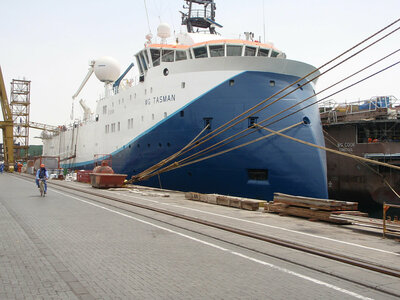
WG Tasman (SW Tasman)
New name: SW Tasman. Delivered as a 12-streamer 3D offshore seismic research vessel of the ULSTEIN SX124 design. Has been converted to a dual ROV seismic vessel. The specifications below are based on the original delivery in 2010.
Primary specifications as built
Additional Data
Ship history
ULSTEIN designed six seismic survey vessels, which WesternGeco received from 2009 to 2010. All six vessels are based on the SX124 design. Two vessels were constructed at Drydocks World—Dubai, and four were built at Barreras, Spain.
The vessels ranged by delivery date:
'WG Columbus': Hull number 1657 from Barreras, Spain, delivered on 16 March 2009. The first X-BOW® vessel to be built outside the Ulstein Verft yard. Later renamed 'SW Columbus'.
'WG Magellan': Hull number 1658 from Barreras, Spain. Due to strikes in the Vigo area in the spring of 2009, WG Magellan was completed in Viana do Castelo, Portugal, and delivered on 29 July 2009. Later renamed 'SW Magellan'.
'WG Amundsen': Hull number 1659 from Barreras, Spain, delivered on 16 February 2010. Later renamed 'SW Amundsen'.
'WG Tasman': Hull number 64 from Drydocks World Dubai, delivered on 31 March 2010. Later renamed 'SW Tasman'.
'WG Vespucci': Hull number 1660 from Barreras, Spain, delivered on 21 April 2010. The vessel left the yard on 24 April for her first mission in the North Sea. Later renamed 'SW Vespucci'.
'WG Cook': hull number 65 from Drydocks World Dubai, delivered on 2 August 2010. Later renamed 'SW Cook'.
2018: Shearwater announced its purchase of WesternGeco's marine seismic acquisition assets and operations by the end of 2018. Therefore, all vessels would change prefixes.
2019, 6 February: SW Tasman and SW Cook received five-month seismic contracts for Aker BP and Equinor, starting in the summer of 2019. For Aker BP, seismic work would be performed at the Frosk, Ivar Aasen, and Valhall fields, beginning in Q2 2019 and lasting approximately four months. After that came the Equinor assignment on the Gullfaks field, lasting about one month from Q3 2019.
2020, January: SW Cook and SW Tasman were awarded an assignment to execute data acquisition on a two-month 4D Qseabed ocean bottom seismic (OBS) project by Lundin Norway for the 2020 North Sea summer season on the Edvard Grieg field, Norway.
2022, October: Decision to convert the SW Tasman to a dual ROV seismic vessel. Ulstein Design & Solutions AS, the original vessel designers, was to provide the conversion engineering. Redesigned to deploy ocean bottom nodes in both deep and shallow water, the vessel will now also be able to offer high-quality sources for surveys and conduct towed streamer surveys. The conversion is an example of how Shearwater can leverage its flexible fleet to provide additional high-end capacity tailored to clients' needs in response to a significant increase in demand for ocean bottom seismic.
Repurposed and upgraded, the SW Tasman is an industry-first high-end seismic vessel. It features dual remotely operated vehicles, vertical movement/heave-compensated launch and recovery systems for ocean bottom node deployment, and seismic sources.
2024, August: The vessel was awarded a three-month extension to Shearwater's major deepwater ocean bottom node (OBN) survey in India. This is the largest deepwater remotely operated vehicle OBN survey in Asia, with depths of up to 2,900 m, and enabled by operational performance, it will be even larger. Shearwater shared their insight and a video of this vessel here.
2024, November: Shearwater will deploy the SW Tasman or a newly awarded deepwater OBN survey offshore West Africa. The one-month program will be the first to feature the vessel’s combined seismic source and dual-ROV node deployment capability for a deepwater OBN survey operation, and it will be the first deployment of Shearwater’s Pearl node technology in the region.
2025, February: The SW Tasman has completed the solo OBN survey offshore of the Ivory Coast. This solo mission eliminated the need for a separate source vessel, reducing fuel use, streamlining permitting, and minimising environmental impact. Shearwater's Pearl nodes were at the heart of this operation, enabling unmatched efficiency. Thanks to their small size and lightweight design, all nodes were deployed in under a week.
2025, August: Shearwater was awarded a two-month deepwater OBN survey by ExxonMobil's affiliate offshore Angola using the SW Tasman platform, Pearl node system, and SW Gallien as source vessel.